产品说明书的翻译
- 格式:ppt
- 大小:103.50 KB
- 文档页数:23
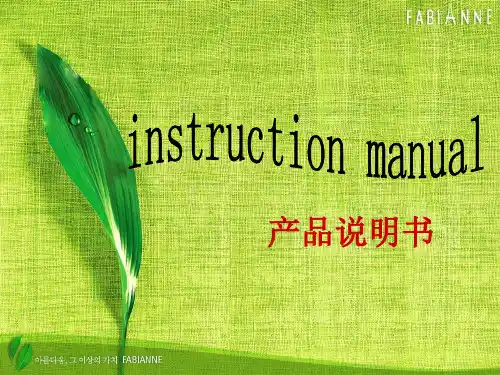
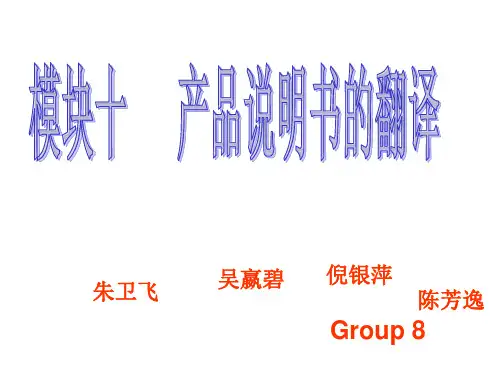
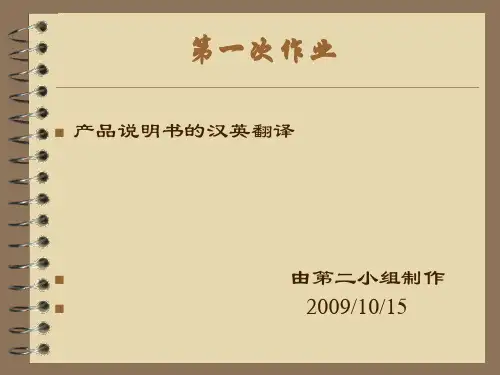

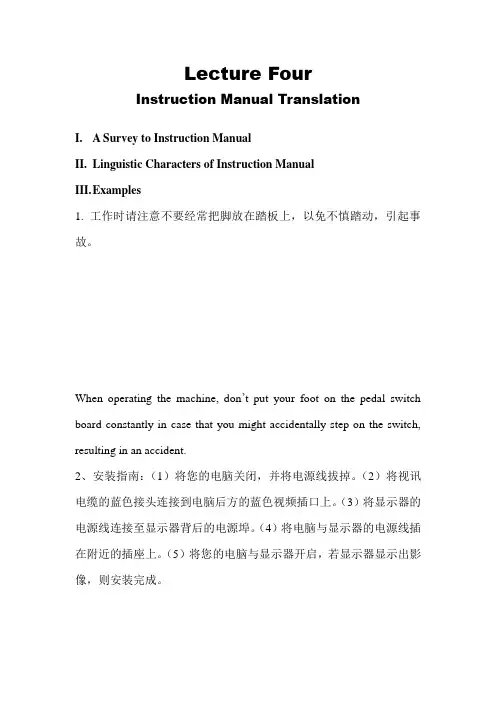
Lecture FourInstruction Manual TranslationI. A Survey to Instruction ManualII.Linguistic Characters of Instruction ManualIII.E xamples1. 工作时请注意不要经常把脚放在踏板上,以免不慎踏动,引起事故。
When operating the machine, don’t put your foot on the pedal switch board constantly in case that you might accidentally step on the switch, resulting in an accident.2、安装指南:(1)将您的电脑关闭,并将电源线拔掉。
(2)将视讯电缆的蓝色接头连接到电脑后方的蓝色视频插口上。
(3)将显示器的电源线连接至显示器背后的电源埠。
(4)将电脑与显示器的电源线插在附近的插座上。
(5)将您的电脑与显示器开启,若显示器显示出影像,则安装完成。
Installation Guide: (1) Turn off your computer and unplug its power cable.(2) Connect the blue connector of the video cable to the blue video connector on the back of your computer. (3) Connect your monitor’s power cable to the power port on the back of the monitor. (4) Plug your computer’s power cord and your monitor into a nearby outlet. (5) Turn on your computer and monitor. If the monitor displays an image, installation is completed.3. 如在使用本产品的过程中,有强烈刺激感、红肿或灼痛现象发生,请立即用温水冲洗干净。
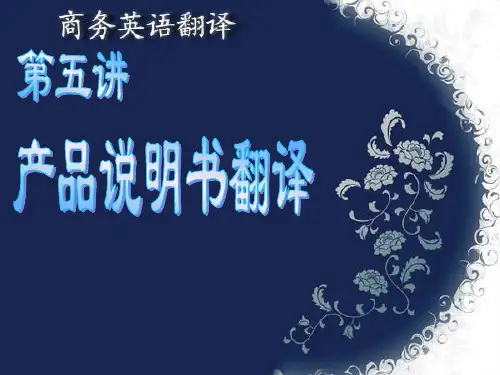
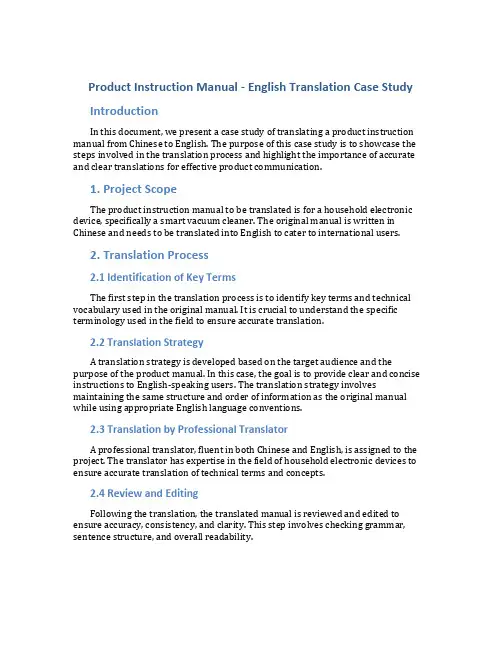
Product Instruction Manual - English Translation Case Study IntroductionIn this document, we present a case study of translating a product instruction manual from Chinese to English. The purpose of this case study is to showcase the steps involved in the translation process and highlight the importance of accurate and clear translations for effective product communication.1. Project ScopeThe product instruction manual to be translated is for a household electronic device, specifically a smart vacuum cleaner. The original manual is written in Chinese and needs to be translated into English to cater to international users.2. Translation Process2.1 Identification of Key TermsThe first step in the translation process is to identify key terms and technical vocabulary used in the original manual. It is crucial to understand the specific terminology used in the field to ensure accurate translation.2.2 Translation StrategyA translation strategy is developed based on the target audience and the purpose of the product manual. In this case, the goal is to provide clear and concise instructions to English-speaking users. The translation strategy involves maintaining the same structure and order of information as the original manual while using appropriate English language conventions.2.3 Translation by Professional TranslatorA professional translator, fluent in both Chinese and English, is assigned to the project. The translator has expertise in the field of household electronic devices to ensure accurate translation of technical terms and concepts.2.4 Review and EditingFollowing the translation, the translated manual is reviewed and edited to ensure accuracy, consistency, and clarity. This step involves checking grammar, sentence structure, and overall readability.2.5 ProofreadingAfter the review and editing process, the translated manual undergoes a final round of proofreading to eliminate any remaining errors or inconsistencies. Attention is paid to language conventions, formatting, and punctuation to ensure a polished final product.3. Challenges and Solutions3.1 Technical TerminologyOne of the main challenges in this translation project was the technical terminology specific to the field of household electronic devices. To overcome this challenge, the translator conducted thorough research and consulted experts in the field to ensure accurate and precise translations.3.2 Cultural AdaptationAnother challenge was ensuring that the translated manual is culturally adapted for English-speaking users. This involved making necessary adjustments to idioms, cultural references, and examples used in the original manual to suit the target audience. The translator worked closely with the review team to ensure the manual is contextually appropriate and easily understood by the English-speaking users.3.3 Quality AssuranceTo ensure the highest quality of translation, multiple rounds of review and proofreading were conducted. This allowed for the identification and correction of any errors or inconsistencies in the translated manual. The project team also utilized translation software tools to enhance the efficiency and accuracy of the translation process.4. ConclusionEffective translation of product instruction manuals is essential for providing clear and accurate information to users. This case study highlighted the various steps involved in translating a product instruction manual from Chinese to English. The use of a professional translator, attention to technical terminology, cultural adaptation, and quality assurance measures contribute to the successful translation of the manual, ultimately enhancing user experience and satisfaction.。
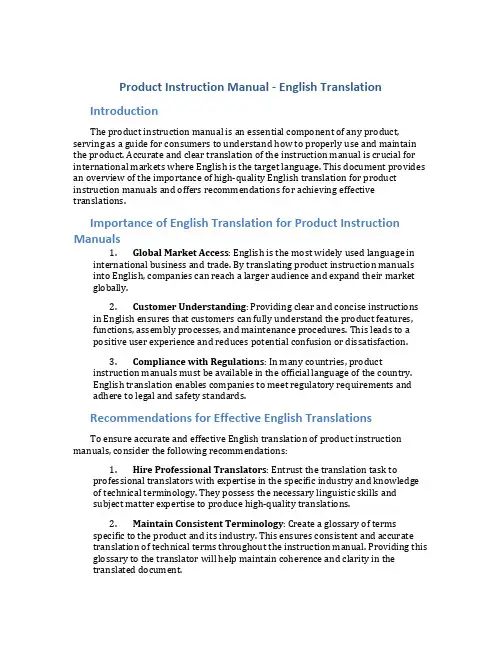
Product Instruction Manual - English Translation IntroductionThe product instruction manual is an essential component of any product, serving as a guide for consumers to understand how to properly use and maintain the product. Accurate and clear translation of the instruction manual is crucial for international markets where English is the target language. This document provides an overview of the importance of high-quality English translation for product instruction manuals and offers recommendations for achieving effective translations.Importance of English Translation for Product Instruction Manuals1.Global Market Access: English is the most widely used language ininternational business and trade. By translating product instruction manuals into English, companies can reach a larger audience and expand their market globally.2.Customer Understanding: Providing clear and concise instructionsin English ensures that customers can fully understand the product features, functions, assembly processes, and maintenance procedures. This leads to apositive user experience and reduces potential confusion or dissatisfaction.pliance with Regulations: In many countries, productinstruction manuals must be available in the official language of the country.English translation enables companies to meet regulatory requirements and adhere to legal and safety standards.Recommendations for Effective English TranslationsTo ensure accurate and effective English translation of product instruction manuals, consider the following recommendations:1.Hire Professional Translators: Entrust the translation task toprofessional translators with expertise in the specific industry and knowledge of technical terminology. They possess the necessary linguistic skills andsubject matter expertise to produce high-quality translations.2.Maintain Consistent Terminology: Create a glossary of termsspecific to the product and its industry. This ensures consistent and accurate translation of technical terms throughout the instruction manual. Providing this glossary to the translator will help maintain coherence and clarity in thetranslated document.3.Consider Cultural Differences: Keep in mind that cultural nuancesmay exist between the source language and English. It is important to ensure that the translated content is culturally appropriate and relevant to the target audience. Understanding the cultural context is crucial in providing accurate translations.4.Simplify Language: Write the original instruction manual in a simpleand clear language. Avoid using complex sentence structures and technicaljargon as they can impede understanding during the translation process.Simpler instructions facilitate accurate and straightforward translations.5.Review and Edit: After the translation is complete, thoroughly reviewand edit the translated content. This helps to identify any errors,inconsistencies, or omissions that might have occurred during the translation process. Editing ensures the final document is accurate and maintains theintended meaning.er-Friendly Presentation: Consider the layout and formatting ofthe translated instruction manual. It should be visually appealing and easy to comprehend. Proper use of headings, subheadings, bullet points, andnumbering enhances readability and user-friendliness.ConclusionAccurate English translations of product instruction manuals are crucial for successful product usage, customer satisfaction, and global market access. By following the recommended guidelines, companies can ensure that their products are effectively communicated to English-speaking customers. A well-translated instruction manual enhances user experience, reduces potential risks associated with product misuse, and fosters a positive brand image in the target market.。
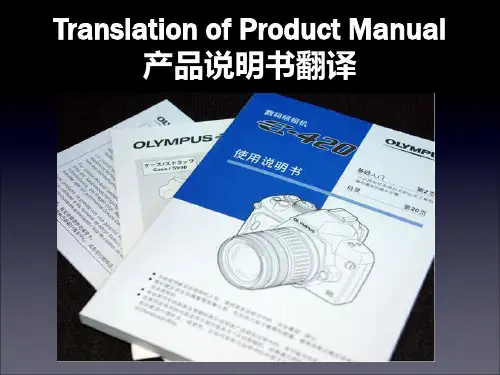
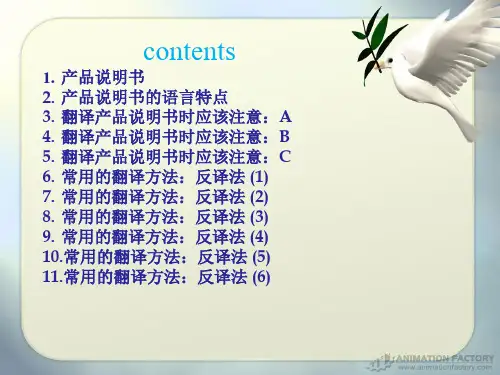
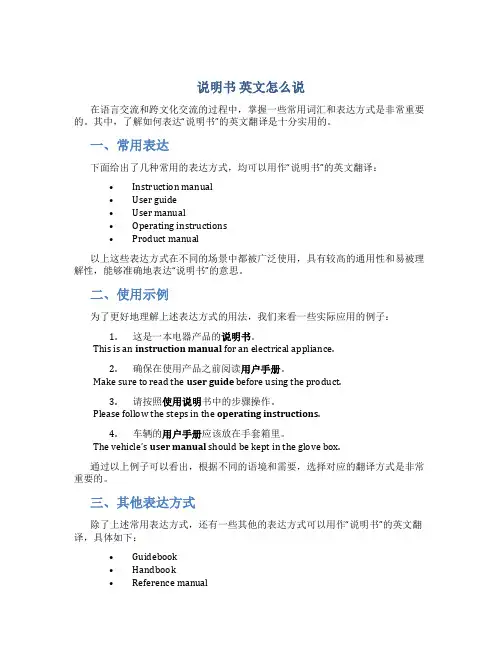
说明书英文怎么说在语言交流和跨文化交流的过程中,掌握一些常用词汇和表达方式是非常重要的。
其中,了解如何表达“说明书”的英文翻译是十分实用的。
一、常用表达下面给出了几种常用的表达方式,均可以用作“说明书”的英文翻译:•Instruction manual•User guide•User manual•Operating instructions•Product manual以上这些表达方式在不同的场景中都被广泛使用,具有较高的通用性和易被理解性,能够准确地表达“说明书”的意思。
二、使用示例为了更好地理解上述表达方式的用法,我们来看一些实际应用的例子:1.这是一本电器产品的说明书。
This is an instruction manual for an electrical appliance.2.确保在使用产品之前阅读用户手册。
Make sure to read the user guide before using the product.3.请按照使用说明书中的步骤操作。
Please follow the steps in the operating instructions.4.车辆的用户手册应该放在手套箱里。
The vehicle’s user manual should be kept in the glove box.通过以上例子可以看出,根据不同的语境和需要,选择对应的翻译方式是非常重要的。
三、其他表达方式除了上述常用表达方式,还有一些其他的表达方式可以用作“说明书”的英文翻译,具体如下:•Guidebook•Handbook•Reference manual•Operation manual这些表达方式在某些特定情境中可能更为合适,比如“Guidebook”通常指的是为旅行提供指导的书籍,与“说明书”有一定的差异。
四、总结掌握一些常用词汇的英文表达方式对于在国际交流和跨文化交流中非常有帮助,特别是对于需要互换文档、指示和说明的场合。
说明书英语怎么说在跨国交流和国际贸易中,掌握常用的英语词汇是十分重要的。
其中,“说明书”是一个常见的词汇,在不同场合下需要用英语来表达。
下面是一些常用的翻译和表达方式:er Manual:这是最常用的表达方式,通常用于电子产品、机械设备等使用说明书。
2.Instruction Manual:与User Manual的意思相同,用于指导产品的正确使用方法。
3.Guidebook:作为说明书的同义词,用于提供有关操作、安装或使用某一产品或系统的详细信息。
4.Operating Manual:也可以用作“说明书”,强调指导使用者正确操作设备或执行任务。
5.Handbook:可以指某一特定主题的详细指南,或是一本包含操作步骤、原则和信息的手册。
6.Reference Manual:用于提供必要的参考信息,通常辅助于其他类型的说明书。
7.Owner’s Manual:主要用于指导消费者正确使用产品、维护和保养的手册。
8.Service Manual:主要用于指导技术人员进行维修或服务。
9.Installation Guide:主要指引用户如何正确安装产品或设备。
10.Quick Start Guide:提供简明的指导,让用户快速了解产品的基本操作。
请注意,实际情况可能因企业或行业的不同而有所不同,因此很可能会存在其他类似的表达方式。
值得一提的是,以上的翻译方式仅为一般性表达,实际运用时可能需要根据具体上下文和需求进行调整。
另外,在文档翻译时,确保所使用的术语和词汇准确、一致,并符合所涉及领域的业界规范。
总之,在跨文化沟通和国际贸易中,准确描述产品说明书的英语表达是必不可少的。
通过熟练掌握以上常用的翻译方式,我们能够更好地与国际伙伴合作,并确保交流的准确性和流畅性。
希望本文提供的信息对您有所帮助!。
END USER TERMS OF USE 最终用户使用条款Safety Instructions安全说明•Installation must be carried out by an Authorized Mobileye Product Dealer or Installer.必须由mobileye产品授权的经销商或安装者进行安装。
•The Product system should not be transferred between vehicles, other than by an Authorized Mobileye Product Dealer or Installer.此产品系统不能用车运输,除非由mobileye产品授权的经销商或安装者进行操作。
•The Product should only be operated with 12VDC ~24VDC power.该产品只能与12到24伏的直流电源相连。
•Do not cover or obstruct the SeeQ camera or the Product display unit.不能覆盖或阻碍SeeQ相机或本产品的显示装置。
•Do not use the Product system for any purpose other than as described in the User Manual.该产品不得用于使用手册描述外的其他任何目的。
WARNINGSA. The Mobileye Product is a driver assistance system which is intended to alert drivers of certain potentially dangerous situations. It does not replace any functions drivers would ordinarily perform in driving a motor vehicle, nor does it decrease the need for drivers to stay vigilant and alert in all driving conditions, to conform to all safe driving standards and practices, and to obey all traffic laws, rules and regulations.该mobileye产品是驾驶员辅助系统,用于提醒司机某些潜在的危险。